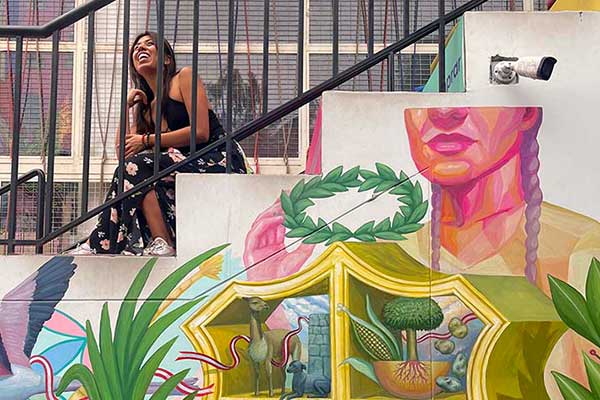Traveling the World to Connect Biology, Computing, and Data

Andrea Chávez Muñoz, E’24, bioengineering, is focusing her future on computational bioengineering, with co-op and internship experiences everywhere from Boston to Switzerland to her home in Lima, Peru.
Andrea Chávez Muñoz, E’24, bioengineering, is on an educational and career journey that spans three continents, crossing national boundaries as well as disciplines as she applies software development and data science to the study of living organisms.
Originally from Lima, Peru, Chávez Muñoz attended high school in New Hampshire, where she discovered an interest in computer coding. She enrolled at Northeastern in 2019, looking for a community similar to the intellectually curious friends she had in high school. Not only did she find that academic community in the College of Engineering, the practical experience she’s built has already made a difference in her co-op work.
Chávez Muñoz settled on a bioengineering major in her first year and leapt at the chance to focus her studies on systems, synthetic, and computational bioengineering when the concentration was first offered. Her computing and biology interests were refined in a co-op at Unravel Biosciences, a Boston-based drug discovery company spun off from the Wyss Institute for Biologically Inspired Engineering at Harvard University. There, she participated in a project using tadpoles as models for testing drugs aimed at Rett syndrome, a rare genetic disease with no cure or treatment. She helped observe the behavior of genetically modified tadpoles to gain insight into drugs’ effects on them.
“You can’t ask a tadpole what it’s feeling,” Chávez Muñoz says, describing the challenge of evaluating tadpole behavior. The solution was a computer vision system, which she helped build and use to observe and precisely quantify the tadpoles’ response to substances being evaluated for Rett syndrome treatment.

Chávez Muñoz with her winning poster at the University of Fribourg, Switzerland
This experience would come in handy the following summer, during Chávez Muñoz’s undergraduate research internship at the University of Fribourg in Switzerland, sponsored by the Swiss National Science Foundation’s National Centre for Competence in Research (NCCR). This time she was focused on ants, working in a lab investigating the role of trophallaxis—a form of nutrient sharing—in communication within an ant colony.
Like the researchers at Unravel Biosciences, the Swiss researchers had cameras to observe their subjects. This time, however, the system was much more complex, consisting of multiple cameras requiring precise synchronization and software integration to function properly. It was implemented using complicated command-line instructions that were so frustrating to use that the lab had largely avoided operating the system before Chávez Muñoz arrived.
She drew on her previous experience with lab vision systems and computer coding to streamline the system, working with its manufacturer to understand the hardware, drivers, and what was wrong with the current implementation. Using that insight, she wrote a custom app with a user-friendly GUI, or graphical user interface, to simplify the camera operation and greatly improve usability.
With Chávez Muñoz’s help, the research proceeded, and before her internship was over, she’d won a poster competition award from NCCR based on her work with the lab.
Northeastern’s co-op program is known for its wide reach, placing students in employment locally, nationally, and around the world. In fact, Chávez Muñoz now finds herself on a co-op at a company called Fácil Insumos Generales back in her hometown of Lima. Though she’s working outside of life sciences this time, she is building extensive technical skill in a crucial component of cutting-edge biological research—data architecture. Her employer, a business-to-business purchasing company, depends heavily on databases to effectively serve its customers. When she started the job, she was presented with a legacy database system that had been inconsistently customized and maintained over many years, with no supporting documentation.
She reviewed and restructured the entire database, creating dozens of interconnected tables, a user-friendly GUI to simplify interaction, and a logistics tracking system to help flexibly direct products from source to destination along branching paths.
“Now I’m working on developing a natural language processing model to read customer histories,” she adds, explaining that orders for the same product were sometimes described differently from time to time. She aims to reduce that ambiguity and increase the speed and accuracy of orders with her natural language processing system.
Work experiences like these have helped Chávez Muñoz clarify her skills and interests and discover where she wants to focus her future study. She hopes to continue working with computer vision systems, perhaps combining them with electrodes and signal processing capabilities that could be used to aid physical therapy and rehabilitation techniques.
“It would include a lot of coding, managing databases, reading signals, and building models to interpret those signals,” she says—all skills that she loves developing and applying to bioscience. Understanding the human body as a collection of signals, says Chávez Muñoz, is an idea that resonates with her.
“I believe we are made out of frequencies. Our muscles emit frequencies, our brains emit frequencies. Being able to understand that—that is what I really want to know.”